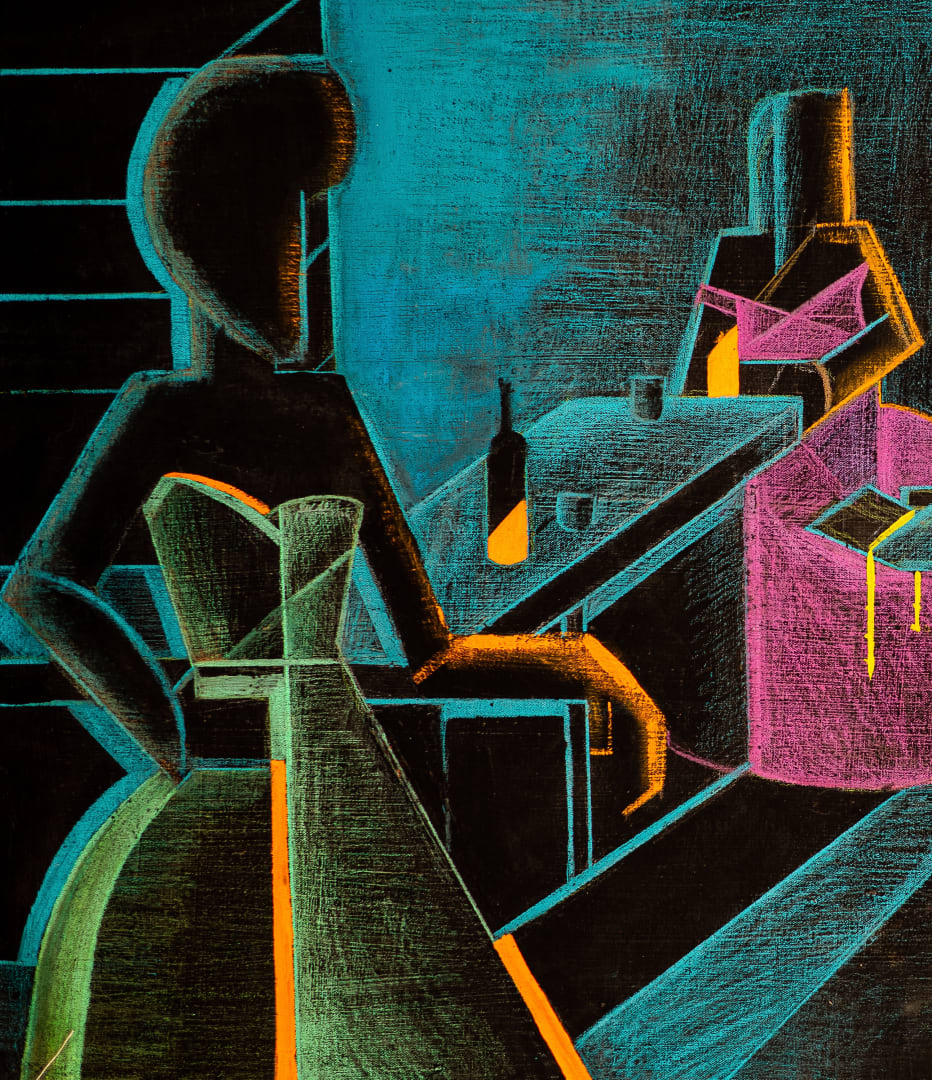Carl-Edouard Keïta, Glass Ceiling
What if the glass ceiling was a black acrylic background? Glass Ceiling, Carl-Edouard Keïta's first solo exhibition in Paris, invites us into a shadow theatre of orange, blue and red colours and lines that seem to emerge with difficulty from a dizzying black background. Here, in the intimacy of the painting's darkness, the forgotten dreams and successes of Afro-descendants from the end of the 19th and beginning of the 20th centuries between France and the United States are recomposed.
The artist has been engaged since the beginning in a research on a Black History of Western modernity, and he meets these forgotten destinies by coming across archives, some of which are now digitalized, circulating or rather emerging in the nebulous space of the Internet and its social networks. In this exhibition, Carl pays particular tribute to these identified sports figures such as Selika Lazevski, a distinguished horsewoman from the Belle Époque in Paris, or Battling Siki, born Amadou Fall, a Senegalese boxer who had a career in Europe and the United States. But also to all those anonymous black lives that one senses when discovering the previous stories.
We know almost nothing about Selika other than this series of portraits taken in 1891 at the Nadar studio, the famous photographic studio of the time. And yet these images contain much more than a written biography. Carl-Edouard retains this young woman's desire to portray herself as dignified, triumphant, beautiful and black. In these portraits, which he reinterprets, she confides her desire to make a living from her passion, her ability to excel in a field that until recently was reserved for men.
At the intersection of gender and race, Selika in her own way broke several glass ceilings in late 19th century French society, which was both post-slavery and in the midst of colonial conquest. She is, and embodies, the disturbing irruption of a black French identity. And the artist re-imagines her here, not isolated in her exceptionality, but in the company of pairs, other black equestrian sisters. How did they create spaces of sisterhood, support, and validity of their existence? Carl-Edouard Keïta invites us to glimpse the potential social forms of these "wayward lives full of beautiful experiments" as theorist Saidiya Hartman would say.
Battling Siki, also featured in this exhibition, had a much more documented life. By winning a fight against the French champion of the time in 1922, he broke a glass ceiling, but far from the recognition expected of his feat, he became the object of a dehumanising media attack. By becoming a champion, by defeating France, the Senegalese boxer, a colonial subject, challenged the colonial order at the same time. Carl-Edouard questions the limits of these broken glass ceilings on a scale of human lives that escapes the great History written afterwards.
Here the glass ceiling is not transparent, it is black, acrylic, from which lines emerge, not without constraint, which the artist deconstructs and recomposes, in a sort of graphic frenzy that translates the conflictuality of these aspirations of the black being to dream in modern Western societies that are themselves paradoxical. At the same time, they are the factory of democracy and its promises of equality and universalism, but also of slavery and colonialism, political projects that are essentially inegalitarian. Black people have to live with these contradictions and duality, and the result is the specific experience of what the African-American sociologist W.E.B Du Bois described at the beginning of the 20th century as the experience of double consciousness.
If we acknowledge that Carl-Edouard is formally in conversation with Cubism, in terms of the search for the fragmentation of space and its representation, then we must specify that he reinscribes the preoccupation of the Cubists in this precise experience of black modernity in the West. A modernity of double consciousness and of the “colour line” to be overcome, an expression also formulated by W.E.B Du Bois as a metaphor for the racism that structures society, and already announced by the sociologist as a major contemporary problem.
But this black background is not just a limit or a ceiling. It conceals in its darkness the noise of other spaces of freedom and creativity, those of the night, of cabarets and other clubs. Battling Siki was fond of them and his body was found dead, murdered outside a club in a bad neighbourhood in New York. In this series of pictures, the boxer is almost a dancer - from the ring to the stage, there is really only one step. This comparison allows Carl-Edouard to consider these sports figures in the broader context of the question of the black body within performance devices where it becomes an object of exotic consumption for the white gaze. Following Bal Noir, his solo exhibition in Dakar (2021), the artist continues to explore these nocturnal places as sites of emergence of artistic modernities and the active, if neglected, contribution of Afrodescendants to these spaces.
In Carl-Edouard Keïta's shadow theatre, the horsewomen meet at nightfall for a drink while other anonymous, elegant creatures pose alone at the bar, independent. In these nocturnal places full of artifice, each one reinvents himself and performs the limits of his identity. In doing so, he creates an imaginary world where identities are multiple and elusive, where the glass ceiling is in reality barely a category capable of capturing the complexity and splendour of these constellations of lives.
Amandine Nana, curator, poet and founder of "Transplantation Project"

